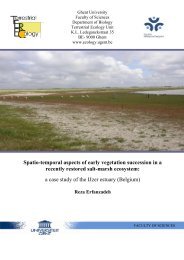PhD Arthur Decae 2010 - Ghent Ecology - Universiteit Gent
PhD Arthur Decae 2010 - Ghent Ecology - Universiteit Gent
PhD Arthur Decae 2010 - Ghent Ecology - Universiteit Gent
You also want an ePaper? Increase the reach of your titles
YUMPU automatically turns print PDFs into web optimized ePapers that Google loves.
Abstract<br />
Seven species of the trapdoor spider genus Nemesia (family Nemesiidae) have recently been<br />
found in the Balearics, five on Majorca and two on Ibiza. Only one of these species N. brauni<br />
(L. Koch 1882) had previously been named and described. Another species, N. bristowei sp.<br />
n., had been reported from Majorca by Bristowe (1941, 1952), but it was never formally<br />
described. The remaining five species are new. Here, supplementary notes and new figures<br />
are given for N. brauni, and six new species are described and figured for the first time.<br />
Additional information on the natural history, behavior and distribution of all seven species is<br />
provided. The six new species are: N. bristowei, N. seldeni sp. n., N. randa sp. n. and N.<br />
santeugenia sp. n., all from Majorca; N. ibiza sp. n. and N. santeulalia sp. n., from Ibiza. All<br />
species are regarded as endemic to the Balearics.<br />
The information on the individual species is preceded by a review of the morphology of<br />
Nemesia at the generic level in order to discuss diagnostic characters for distinguishing<br />
species.<br />
Introduction<br />
Among the Mygalomorphae, the genus<br />
Nemesia is comparatively rich in species. A<br />
survey of Platnick's (2003) catalogue shows<br />
that Nemesia currently ranks fifth in a list of<br />
303 mygalomorph genera (Table1). Large<br />
genera usually have large areas of<br />
distribution. The largest mygalomorph<br />
genus, Idiops, occurs in Africa, Asia and<br />
South America, and the second largest<br />
genus, Aphonopelma, although concentrated<br />
in North America, also has South American<br />
representatives. According to Platnick's list,<br />
Nemesia also has an almost cosmopolitan<br />
distribution. The reality of this wide<br />
occurrence, however, is biogeographically<br />
difficult to explain, because of a curious<br />
discontinuous distribution, with single<br />
species recorded from China, Afghanistan, Mozambique and Cuba and approximately fifty<br />
species reported from one relatively small geographical zone. In fact the distribution of<br />
Nemesia is concentrated around the western, central, and parts of the eastern Mediterranean. It<br />
is bordered by Alpine mountain ranges in the north, the Sahara desert in the south and the<br />
Atlantic Ocean in the west (see Chapter 2, Fig. 5). In North Africa the genus is reported from<br />
as Far East as Egypt, and in southern Europe as far east as Cyprus 13 . Nemesia is not known<br />
from Anatolia, where it seems to be replaced by the related genus Brachythele Ausserer 1871.<br />
The high species diversity of Nemesia in the restricted geographical zone around the western<br />
and central Mediterranean might tentatively be explained by the combined effects of poor<br />
powers of dispersal and strong allopatric speciation in an area that has been fragmented for<br />
millions of years by tectonic activity and/or that has seen numerous relict populations formed<br />
in an area that, in the not too distant past, has been affected by Pleistocene glaciations. The<br />
reality of such speculation, however, remains to be investigated, but it could possibly explain<br />
why so many, if not all, Nemesia species seem to be local endemics.<br />
13 Not shown in Fig. 1.










